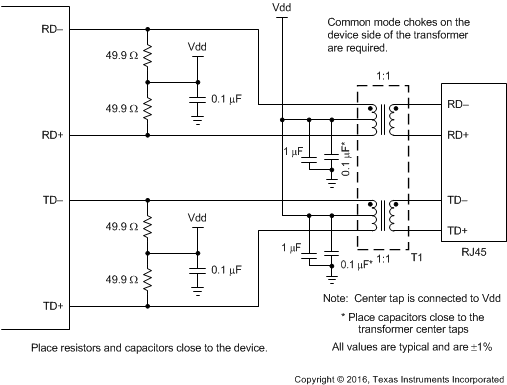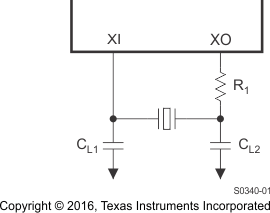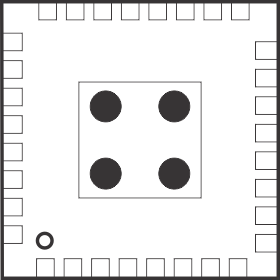SLLSEB8C August 2012 – April 2016 TLK105 , TLK106
PRODUCTION DATA.
- 1 Introduction
- 2 Pin Descriptions
- 3 Hardware Configuration
- 4 Interfaces
-
5 Architecture
- 5.1 100Base-TX Transmit Path
- 5.2
100Base-TX Receive Path
- 5.2.1 Analog Front End
- 5.2.2 Adaptive Equalizer
- 5.2.3 Baseline Wander Correction
- 5.2.4 NRZI and MLT-3 Decoding
- 5.2.5 Descrambler
- 5.2.6 5B/4B Decoder and Nibble Alignment
- 5.2.7 Timing Loop and Clock Recovery
- 5.2.8 Phase-Locked Loops (PLL)
- 5.2.9 Link Monitor
- 5.2.10 Signal Detect
- 5.2.11 Bad SSD Detection
- 5.3 10Base-T Receive Path
- 5.4 Auto Negotiation
- 5.5 Link Down Functionality
- 6 Reset and Power Down Operation
- 7 Design Guidelines
-
8 Register Block
- 8.1
Register Definition
- 8.1.1 Basic Mode Control Register (BMCR)
- 8.1.2 Basic Mode Status Register (BMSR)
- 8.1.3 PHY Identifier Register 1 (PHYIDR1)
- 8.1.4 PHY Identifier Register 2 (PHYIDR2)
- 8.1.5 Auto-Negotiation Advertisement Register (ANAR)
- 8.1.6 Auto-Negotiation Link Partner Ability Register (ANLPAR) (BASE Page)
- 8.1.7 Auto-Negotiate Expansion Register (ANER)
- 8.1.8 Auto-Negotiate Next Page Transmit Register (ANNPTR)
- 8.1.9 Auto-Negotiation Link Partner Ability Next Page Register (ANLNPTR)
- 8.1.10 Control register 1 (CR1)
- 8.1.11 Control register 2 (CR2)
- 8.1.12 Control Register 3 (CR3)
- 8.1.13 Extended Register Addressing
- 8.1.14 PHY Status Register (PHYSTS)
- 8.1.15 PHY Specific Control Register (PHYSCR)
- 8.1.16 MII Interrupt Status Register 1 (MISR1)
- 8.1.17 MII Interrupt Status Register 2 (MISR2)
- 8.1.18 False Carrier Sense Counter Register (FCSCR)
- 8.1.19 Receiver Error Counter Register (RECR)
- 8.1.20 BIST Control Register (BISCR)
- 8.1.21 RMII Control and Status Register (RCSR)
- 8.1.22 LED Control Register (LEDCR)
- 8.1.23 PHY Control Register (PHYCR)
- 8.1.24 10Base-T Status/Control Register (10BTSCR)
- 8.1.25 BIST Control and Status Register 1 (BICSR1)
- 8.1.26 BIST Control and Status Register2 (BICSR2)
- 8.2 Cable Diagnostic Control Register (CDCR)
- 8.3 PHY Reset Control Register (PHYRCR)
- 8.4 Compliance Test register (COMPTR)
- 8.5 TX_CLK Phase Shift Register (TXCPSR)
- 8.6 Power Back Off Control Register (PWRBOCR)
- 8.7 Voltage Regulator Control Register (VRCR)
- 8.8
Cable Diagnostic Configuration/Result Registers
- 8.8.1 ALCD Control and Results 1 (ALCDRR1)
- 8.8.2 Cable Diagnostic Specific Control Registers (CDSCR1 - CDSCR4)
- 8.8.3 Cable Diagnostic Location Results Register 1 (CDLRR1)
- 8.8.4 Cable Diagnostic Location Results Register 2 (CDLRR2)
- 8.8.5 Cable Diagnostic Location Results Register 3 (DDLRR3)
- 8.8.6 Cable Diagnostic Location Results Register 4 (CDLRR4)
- 8.8.7 Cable Diagnostic Location Results Register 5 (CDLRR5)
- 8.8.8 Cable Diagnostic Amplitude Results Register 1 (CDARR1)
- 8.8.9 Cable Diagnostic Amplitude Results Register 2 (CDARR2)
- 8.8.10 Cable Diagnostic Amplitude Results Register 3 (CDARR3)
- 8.8.11 Cable Diagnostic Amplitude Results Register 4 (CDARR4)
- 8.8.12 Cable Diagnostic Amplitude Results Register 5 (CDARR5)
- 8.8.13 Cable Diagnostic General Results Register (CDGRR)
- 8.8.14 ALCD Control and Results 2 (ALCDRR2)
- 8.1
Register Definition
-
9 Electrical Specifications
- 9.1 Absolute Maximum Ratings
- 9.2 ESD Ratings
- 9.3 Recommended Operating Conditions
- 9.4 145
- 9.5 TLK106 32-Pin Extended Temperature (105°C) Device Thermal Characteristics
- 9.6 DC Characteristics, VDD_IO
- 9.7 DC Characteristics
- 9.8 Power Supply Characteristics
- 9.9
AC Specifications
- 9.9.1 Power Up Timing
- 9.9.2 Reset Timing
- 9.9.3 MII Serial Management Timing
- 9.9.4 100Mb/s MII Transmit Timing
- 9.9.5 100Mb/s MII Receive Timing
- 9.9.6 100Base-TX Transmit Packet Latency Timing
- 9.9.7 100Base-TX Transmit Packet Deassertion Timing
- 9.9.8 100Base-TX Transmit Timing (tR/F and Jitter)
- 9.9.9 100Base-TX Receive Packet Latency Timing
- 9.9.10 100Base-TX Receive Packet Deassertion Timing
- 9.9.11 10Mbs MII Transmit Timing
- 9.9.12 10Mb/s MII Receive Timing
- 9.9.13 10Base-T Transmit Timing (Start of Packet)
- 9.9.14 10Base-T Transmit Timing (End of Packet)
- 9.9.15 10Base-T Receive Timing (Start of Packet)
- 9.9.16 10Base-T Receive Timing (End of Packet)
- 9.9.17 10Mb/s Jabber Timing
- 9.9.18 10Base-T Normal Link Pulse Timing
- 9.9.19 Auto-Negotiation Fast Link Pulse (FLP) Timing
- 9.9.20 100Base-TX Signal Detect Timing
- 9.9.21 100Mbs Loopback Timing
- 9.9.22 10Mbs Internal Loopback Timing
- 9.9.23 RMII Transmit Timing
- 9.9.24 RMII Receive Timing
- 9.9.25 Isolation Timing
- 10Revision History
パッケージ・オプション
デバイスごとのパッケージ図は、PDF版データシートをご参照ください。
メカニカル・データ(パッケージ|ピン)
- RHB|32
サーマルパッド・メカニカル・データ
- RHB|32
発注情報
7 Design Guidelines
7.1 TPI Network Circuit
Figure 7-1 shows the recommended circuit for a 10/100Mbs twisted pair interface. Common mode chokes on the device side of the transformer are required. Variations with PCB and component characteristics require that the application be tested to verify that the circuit meets the requirements of the intended application.
 Figure 7-1 10/100Mbs Twisted Pair Interface
Figure 7-1 10/100Mbs Twisted Pair Interface
7.2 Clock In (XI) Requirements
The TLK10x supports an external CMOS-level oscillator source or an internal oscillator with an external crystal.
7.2.1 Oscillator
If an external clock source is used, XI should be tied to the clock source and XO should be left floating. The oscillator should use the same supply voltage as the VDD_IO supply. When operating in RMII, the oscillator supply voltage must be 3.3V or 2.5V.
7.2.2 Crystal
The use of a 25MHz, parallel, 20pF-load crystal is recommended if a crystal source is desired. Figure 7-2 shows a typical connection for a crystal resonator circuit. The load capacitor values will vary with the crystal vendors; check with the vendor for the recommended loads.
The oscillator circuit is designed to drive a parallel-resonance AT-cut crystal with a minimum drive level of 100μW and a maximum of 500μW. If a crystal is specified for a lower drive level, a current limiting resistor must be placed in series between XO and the crystal.
As a starting point for evaluating an oscillator circuit, if the requirements for the crystal are not known, set the values for CL1 and CL2 at 33pF, and R1 should be set at 0Ω. Specifications for a 25MHz crystal are listed in Table 7-3.
 Figure 7-2 Crystal Oscillator Circuit
Figure 7-2 Crystal Oscillator Circuit
Table 7-1 25MHz Oscillator Specification
| PARAMETER | TEST CONDITIONS | MIN | TYP | MAX | UNIT |
|---|---|---|---|---|---|
| Frequency | 25 | MHz | |||
| Frequency Tolerance | Operational Temperature | ±50 | ppm | ||
| Frequency Stability | 1 year aging | ±50 | ppm | ||
| Rise / Fall Time | 10%–90% | 8 | nsec | ||
| Jitter (Short term) | Cycle-to-cycle | 50 | psec | ||
| Jitter (Long term) | Accumulative over 10 ms | 1 | nsec | ||
| Symmetry | Duty Cycle | 40% | 60% | ||
| Load Capacitance | 15 | 30 | pF |
Table 7-2 50MHz Oscillator Specification
| PARAMETER | TEST CONDITIONS | MIN | TYP | MAX | UNIT |
|---|---|---|---|---|---|
| Frequency | 50 | MHz | |||
| Frequency Tolerance | Operational Temperature | ±50 | ppm | ||
| Frequency Stability | 1 year aging | ±50 | ppm | ||
| Rise / Fall Time | 10%–90% | 6 | nsec | ||
| Jitter (Short term) | Cycle-to-cycle | 50 | psec | ||
| Jitter (Long term) | Accumulative over 10 ms | 1 | nsec | ||
| Symmetry | Duty Cycle | 40% | 60% |
Table 7-3 25MHz Crystal Specification
| PARAMETER | TEST CONDITIONS | MIN | TYP | MAX | UNIT |
|---|---|---|---|---|---|
| Frequency | 25 | MHz | |||
| Frequency Tolerance | Operational Temperature | ±50 | ppm | ||
| At 25°C | ±50 | ppm | |||
| Frequency Stability | 1 year aging | ±5 | ppm | ||
| Load Capacitance | 10 | 40 | pF |
7.3 Thermal Vias Recommendation
The following thermal via guidelines apply to DOWN_PAD, pin 33:
- Thermal via size = 0.2mm
- Recommend 4 vias
- Vias have a center to center separation of 2mm.
Adherence to this guideline is required to achieve the intended operating temperature range of the device. Figure 7-3 illustrates an example layout.
 Figure 7-3 Example Layout
Figure 7-3 Example Layout